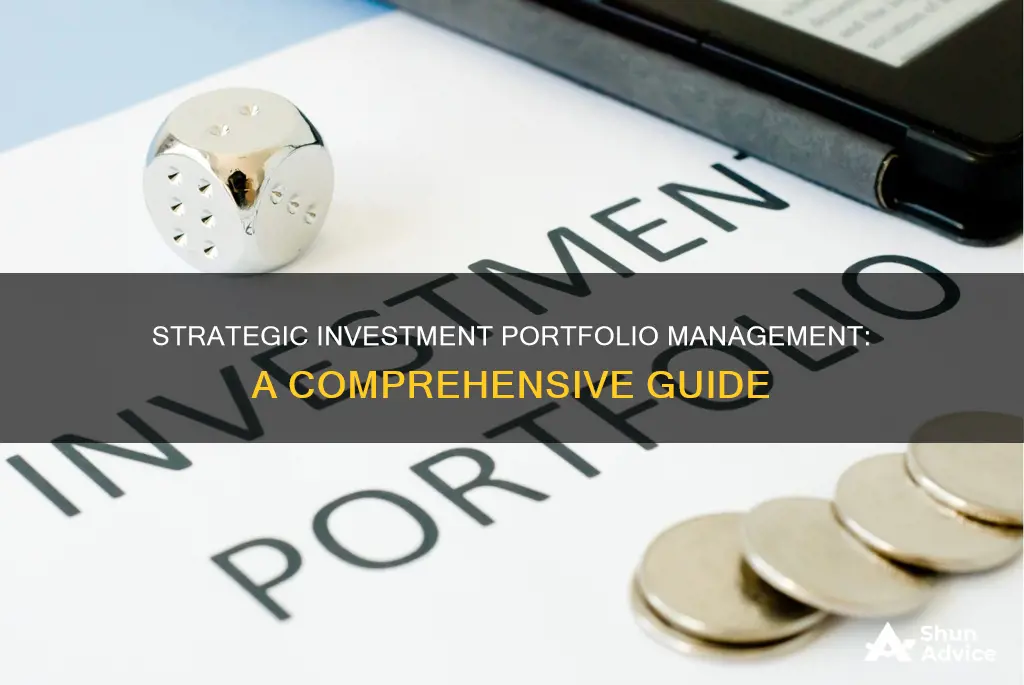
Managing an investment portfolio can be a complex task, but it is a crucial step in creating wealth. It involves selecting and managing a set of investments that align with an individual's financial goals and risk tolerance. The goal is to maximise returns while minimising risk by holding a diverse range of assets, which may include stocks, bonds, real estate, and more. To successfully manage a portfolio, it is essential to commit time and energy to gathering information, analysing, and making adjustments. This includes understanding basic investment concepts such as asset allocation and rebalancing, as well as keeping costs low and considering the long-term impact of investment decisions. While some individuals choose to manage their portfolios themselves, others may seek the assistance of financial advisors or robo-advisors to provide professional guidance and expertise.
| Characteristics | Values |
|---|---|
| Investment goals | Long-term goals like retirement, medium-term goals like a down payment for a house or a child's college education |
| Risk tolerance | Conservative, aggressive, or in between |
| Investment methods | Passive management, active management |
| Asset allocation | Stocks, bonds, cash, real estate, commodities, cryptocurrency, mutual funds, exchange-traded funds (ETFs) |
| Investment costs | Management fees, trading commissions, fund management fees, fund fees |
| Investment research | Newsletters, financial management programs, online brokers, financial advisers, robo-advisers |
| Investment accounts | Brokerage account, 401(k) retirement plan, Individual Retirement Account (IRA) |
| Investment portfolio rebalancing | Once or twice a year, whenever an asset class deviates from the rules |
| Investment portfolio monitoring | Regular, annual |
| Investment portfolio adjustments | Sell stocks in overweight asset classes, purchase stocks in underweight asset classes |
What You'll Learn

Learn basic investment concepts
Before you start managing your investment portfolio, it is important to understand some basic investment concepts. Here are some key concepts to get you started:
- Investment Portfolio Management: This refers to the process of selecting and managing various investments to meet specific goals. It involves making strategic choices, such as asset allocation, investing strategies, and risk management.
- Passive vs. Active Management: Passive management involves accepting market returns and using a fixed asset allocation, such as investing in index funds. Active management, on the other hand, involves a portfolio manager who actively tries to meet investment objectives through dynamic asset allocation and strategies tailored to the portfolio owner.
- Asset Allocation: This is the process of determining how to distribute your investments across different asset classes, such as equities (stocks), bonds, and cash. A popular mix is 60% equities, 30% bonds, and 10% cash.
- Strategic vs. Tactical Asset Allocation: Strategic asset allocation involves a fixed portfolio mix based on the investor's profile, while tactical asset allocation allows for changes in response to market conditions.
- Investing Strategies: These are approaches to selecting and managing investments. Examples include value investing (buying assets below their intrinsic value), contrarian investing (buying assets that are bargains and using behavioural science), and growth investing (investing in growth companies).
- Diversification: Diversification is a risk management technique where you spread your investments across various assets, industries, and regions to reduce risk and maximise returns. It's important to set rules and limits to maintain a diversified portfolio.
- Rebalancing: Over time, your portfolio's asset allocation may deviate from your original plan due to market fluctuations. Rebalancing involves periodically adjusting your portfolio to restore your desired asset allocation and maintain alignment with your investment goals and risk tolerance.
- Risk Management: Understanding your risk tolerance is crucial. Consider your capacity for risk (based on age, time horizon, income, etc.) and your willingness to take on risk. This will guide your investment decisions and help you set rules for buying and selling.
- Investment Costs and Fees: Be mindful of the costs associated with investing, such as management fees, trading commissions, and fund management fees. Lower-fee funds and infrequent trading can help minimise costs.
- Long-Term Perspective: Investing is typically a long-term endeavour. Maintain a disciplined approach, avoid emotional decisions, and regularly invest over the long term to maximise your chances of achieving your financial goals.
Best Sites for Tracking Your Investment Portfolio
You may want to see also

Understand asset allocation
Understanding asset allocation is a key part of managing an investment portfolio. Asset allocation is the process of dividing your portfolio among various types of investments, such as stocks, bonds, and cash. The goal of asset allocation is to balance risk and return by diversifying your portfolio across different types of assets.
When determining your asset allocation strategy, it is important to consider your financial goals and risk tolerance. If you have a low-risk tolerance, you may want to allocate a larger portion of your portfolio to less risky assets like bonds and cash, while those with a higher risk tolerance may choose to invest more heavily in stocks. It's important to remember that different assets perform differently in different market conditions. For example, stocks may struggle during an economic downturn, while bonds and gold tend to perform better. By having a mix of assets, you can balance out the risks and returns of your portfolio.
There are two main types of asset allocation strategies: strategic asset allocation and tactical asset allocation. With a strategic asset allocation, the portfolio mix is fixed according to the investor's profile and financial goals. A common example of this is the 60/30/10 portfolio, which consists of 60% stocks, 30% bonds, and 10% cash. This type of allocation is considered passive management, as it does not change based on market conditions.
On the other hand, tactical asset allocation is more flexible and dynamic. With this strategy, the portfolio mix can be adjusted as market conditions change. This approach involves actively managing risk through portfolio rebalancing, ensuring that the allocation stays in line with the investor's goals and risk tolerance.
It is also important to regularly monitor and rebalance your portfolio to maintain your desired asset allocation. Over time, the performance of different assets will cause the allocation to shift. For example, if stocks have been performing well, they may start to make up a larger portion of your portfolio than intended. By rebalancing, you can sell some of the stocks and purchase more of the underweighted assets to return your portfolio to the desired allocation.
Additionally, when investing in multiple assets, it is crucial to ensure they are not highly correlated. Correlated assets tend to move in the same direction, so if they are highly correlated, their prices may rise and fall together. By choosing assets that are not highly correlated, you can reduce the impact of market downturns on your portfolio.
Understanding asset allocation and creating a well-diversified portfolio can help you manage your investments effectively and increase your chances of achieving your financial goals.
Saving's Leakage and Planned Investment: A Balancing Act
You may want to see also

Know your risk tolerance
Knowing your risk tolerance is a crucial aspect of managing an investment portfolio. It is essential to understand your risk comfort levels and build a portfolio that aligns with them. This means evaluating your capacity and willingness to take on risk. Your capacity is influenced by factors such as your age, time horizon, income, and financial situation.
When determining your risk tolerance, it is important to be honest with yourself. Ask yourself how comfortable you are with the potential for losses. Are you willing to take on more risk for higher potential returns, or do you prefer a more conservative approach with lower risk? Your answer to this question will guide the types of investments you make. For example, if you have a low-risk tolerance, you may want to allocate a smaller proportion of your portfolio to stocks and favour more stable investments such as bonds and cash. On the other hand, if you have a higher risk tolerance, you may be comfortable with a larger allocation of stocks in your portfolio.
It is also important to consider the impact of market volatility on your portfolio. Market downturns and economic downturns can affect the performance of your investments. By understanding your risk tolerance, you can decide how to balance your portfolio to mitigate these risks. For instance, during an economic downturn, stocks may falter, but bonds and gold might perform better. By holding a mix of assets, you can reduce the overall impact of market volatility on your portfolio.
Additionally, it is crucial to monitor and adjust your portfolio periodically to ensure it remains aligned with your risk tolerance. Over time, your circumstances may change, and your capacity or willingness to take on risk may shift. Regularly evaluating your risk tolerance will help you make any necessary adjustments to your investment strategy.
Crafting a Diversified Portfolio with Fidelity Investments
You may want to see also

Regularly monitor and rebalance your portfolio
Regularly monitoring and rebalancing your portfolio is essential to ensure it remains aligned with your investment goals and risk tolerance. Here are some detailed guidelines on how to do this effectively:
Firstly, establish a schedule for monitoring your portfolio. While the frequency may vary depending on your specific circumstances and goals, a general recommendation is to review your portfolio at least annually. Set aside time to thoroughly analyse your investments, assess their performance, and make any necessary adjustments.
During your review, pay close attention to your asset allocation. Over time, the performance of different investments can cause your portfolio's composition to deviate from your original plan. For example, if stocks have risen and bonds have fallen since your last review, your portfolio may now have a higher proportion of stocks than intended.
To restore balance, you can employ one of two strategies. The first is to use new capital to purchase shares of the underweighted assets. For example, if your target allocation for bonds is 30% but due to market fluctuations, it has dropped to 20%, you can buy more bonds to increase their representation in your portfolio.
The second strategy involves selling a portion of the assets that have exceeded their target allocation and using the proceeds to buy more of the underweighted assets. For instance, if your target for stocks was 50% but it has increased to 60% due to strong market performance, you can sell some stocks and use the funds to buy more bonds.
It is important to note that selling assets may have tax implications, so be sure to consider the tax impact of any changes before executing them. Additionally, if you are investing in a taxable account, try to prioritise using new capital to purchase shares of underweighted assets before resorting to selling.
Another aspect to consider during your review is the performance of individual investments. Evaluate whether each investment is meeting your expectations and still aligns with your overall strategy. If certain investments are consistently underperforming or are no longer suitable for your goals, consider replacing them with alternative options.
By regularly monitoring and rebalancing your portfolio, you can ensure that it remains consistent with your financial objectives and risk tolerance. This process helps maintain a balanced mix of investments, reducing the risk of being overly exposed to any single asset or industry. Remember, investing is a long-term endeavour, and by staying disciplined and making adjustments as needed, you can maximise your chances of achieving your financial goals.
Planning Savings and Investments: Strategies for Financial Freedom
You may want to see also

Minimise costs
Fees are an inevitable part of investing, but there are ways to reduce them. Here are some strategies to minimise costs when managing an investment portfolio:
Choose a Commission-Free Brokerage
Commissions are transaction fees charged by brokers every time you buy or sell an asset like stocks, exchange-traded funds (ETFs), or mutual funds. These fees can quickly add up, so choosing a brokerage that doesn't charge commissions is a simple way to keep costs down. Examples of commission-free brokerages include Charles Schwab, TD Ameritrade, Robinhood, M1 Finance, and eTrade.
Opt for Free Bank Accounts
Many banks charge monthly maintenance fees for checking and savings accounts, often waiving these fees if you maintain a certain minimum balance. Instead, opt for reputable free checking accounts from online institutions like Go2Bank or Varo. For savings accounts, choose an option that not only waives monthly fees but also pays you a high interest rate. CIT Bank Savings Builder is a good example.
Pick a Low-Cost Health Savings Account (HSA)
HSAs vary in their fee structures, with some charging a percentage of assets under management, a flat monthly fee, or account opening/closing fees. Lively is an example of a platform that charges no ongoing fees, or waives the fee if you maintain a minimum balance. These accounts offer unique tax advantages, so it's worth shopping around for a low-cost option.
Invest in Low-Cost Index Funds
Index funds are passively managed funds that mirror major stock indexes. They typically have lower expense ratios than actively managed mutual funds, which try to beat market returns through professional fund management. As a result, index funds tend to have lower costs. Fidelity, for example, offers funds with zero expense ratios and no minimum investment.
Choose No-Load Mutual Funds
Mutual funds can charge fees when you buy or sell them, known as "load" fees. "A share" funds charge a front-end load, meaning you pay a fee upfront when buying shares. "B share" funds charge a back-end load, or a fee when you sell. "C share" funds charge an ongoing service fee on top of the annual expense ratio. To minimise costs, opt for no-load mutual funds, which don't charge these fees.
Scrutinise Your 401(k) for Hidden Fees
Many 401(k) plans offer a limited selection of funds with high fees and expense ratios. Even worse, some include hidden fees like advisory fees, transaction fees, and record-keeping fees. Use tools like Personal Capital's Investment Checkup tool to uncover these hidden costs and understand how they compound over time.
Don't Try to Time the Market
Timing the market can lead to higher taxes, as buying and selling shares within a year incurs the regular income tax rate on capital gains. It can also lead to emotional investing and poor decisions. Instead, automate your investments to save time and avoid the stress of trying to outsmart the market.
Use a Free Robo-Advisor
Human advisors can be expensive, so consider using a robo-advisor, which utilises artificial intelligence to manage your investments. These services often outperform human advisors as they don't panic, get "hunches", and can process data much faster. Examples include Schwab's Intelligent Portfolio service, which is free for investors with at least $5,000 invested.
Pay a Flat Fee for Human Financial Advice
Traditional investment advisors often charge an ongoing fee, typically a percentage of your assets under management, which can add up quickly. Instead, consider hiring an advisor by the hour or paying a flat fee. This way, you can still get the human touch when you need it without a hefty price tag.
Diversify Your Portfolio
Diversification is a well-known strategy to reduce risk, but it can also help minimise costs. By spreading your investments across a variety of asset classes, industries, countries, and company sizes, you reduce the impact of any single investment. This can help you avoid impulsive decisions that may incur unnecessary fees or losses.
Regularly Rebalance Your Portfolio
Review your portfolio regularly to ensure it aligns with your goals and risk tolerance. For example, if you initially allocated 60% of your portfolio to stocks and 40% to bonds, market movements may cause this allocation to shift. By revisiting your asset allocation annually, you can make adjustments to stay within your risk tolerance.
Take a Long-Term Investment Approach
Patience is key when investing. Avoid making impulsive decisions during market volatility. Remember that investments have the potential to recover and grow over time. Selling prematurely can cause you to miss out on future gains.
Choose Low-Cost Funds
Whether it's mutual funds or ETFs, always be mindful of the fees associated with the funds you choose. Opt for low-cost funds to keep your overall investing costs down.
Understand All Costs Involved
The first step to minimising costs is to understand what you're paying. Pay attention to brokerage commissions, fund expense ratios, bank account fees, and 401(k) fees. There are often free or low-cost alternatives available that can help you keep more of your money working for you.
Computing Investment Gains: Maximizing Your Portfolio Returns
You may want to see also
Frequently asked questions
The goal of portfolio management is to maximize expected returns while minimizing risk by holding a diverse range of assets.
The first step to managing a portfolio is to establish financial goals and risk tolerance.
Passive management is for investors who are willing to accept market returns. It involves using a fixed asset allocation with a portfolio comprised of index funds.
In active management, the portfolio manager attempts to meet investment objectives through asset allocation investing and strategies that fit the portfolio owner.
Some tips for successful portfolio management include:
- Regularly monitoring and rebalancing your portfolio to maintain alignment with investment goals and risk tolerance.
- Keeping costs to a minimum.
- Considering the long term.
- Staying diversified.







